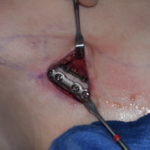Background: Double jaw or Bimax surgery is a popular procedure today often done for improving skeletal facial projection as well as in the treatment of significant obstructive sleep apnea. These facial osteotomy movements are often significant often 10mms forward movements or greater. This is very different than in the history of jaw surgery, where it was known as orthognathic surgery, whose primary purpose was in the treatment of dentofacial deformities or alignment of the dentoalveolar segments.
While double jaw surgery provides numerous benefits it does create its own aesthetic liabilities. Such large bony movements will create various bony stepoffs of the maxilla and lower jaw from Lefort I and sagittal split osteotomies (and sliding geniplasty) which cause changes of the natural bony contours. Most are palpable and some of these irregularities can be seen externally if the face is thin enough. Such large sagittal or forward projecting bony facial movements can make the face more narrow as they have limited to no capability to widen the face at any level. Also a large anterior movement of a LeFort I osteotomy does not not affect the entire midface and, as a result, the undereye and cheek areas may become more hollow or deficient after the surgery.
While some bony step offs can be treated by more conventional bine reshaping procedures many require s larger and more controlled way of bony contouring and augmentations. This is where the role of custom implant comes into play.





It is not rare to see a patient for a custom jawline implant after double jaw surgery for the combined effect of making the bone smooth from one angle to the other as well as adding any additional dimensional augmentative changes.The irregular bone and the presence of hardware does not make the necessary dissection any more limiting.
Key Points:
1) Double jaw or Bimax surgery can create multiple bony irregularities and deficiencies of the midface and jawline for which secondary custom implants can improve.
2) Significant maxillary advancements can leave the upper midface behind creating an aesthetic midface deficiency
3) The combination of sagittal splits and chin osteotomies can create bony irregularities/stepoffs and width deficiencies.
Dr. Barry Eppley
World-Renowned Plastic Surgeon





